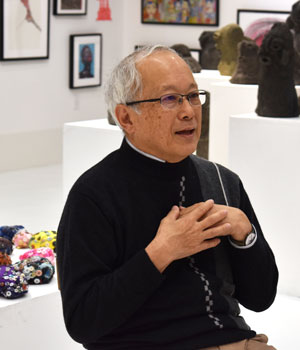 |
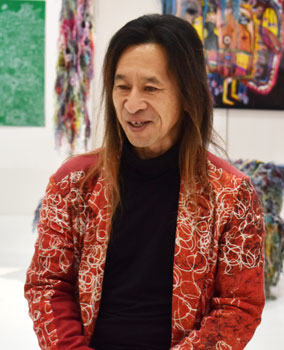 |
|
|---|---|---|
The evaluation of our artwork does not matter so much; we just want to be here together
Sakakihara: I am a pediatrician and have seen a great many children with developmental disorders, such as autism and intellectual disabilities. Therefore, I know that some of these children love drawing and have a special talent for it.
Nevertheless, I was very surprised when I visited Atelier Yamanami to learn that nearly one hundred members with disabilities are gathered in Koka City, a limited community of about 90,000 residents, to engage in artistic activities and create beautiful artwork.
We, as human beings, live in a collaborative society by following common rules using a common language. Certain people are not good at speaking or writing and find it difficult to communicate with others. However, these people may have an enriched inner world which gives them the potential to produce beautiful artwork. I am very impressed with this.
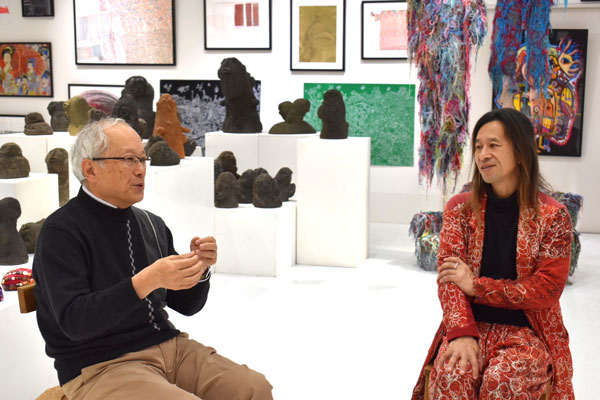
Yamashita: Thank you for your comment. Atelier Yamanami was established in 1986 with just three users. At that time, there were limited job opportunities for people over 18 years old with disabilities, even if they had enough skills and were willing to work. Many of them had no choice but to stay at home all day. Atelier Yamanami was created to provide a place for such individuals.
At the beginning, I had the vague idea that we should help them adapt to society by providing work opportunities, or was thinking about how to help them fit into the framework of "labor." However, I realized that I did not have the expertise of a social welfare specialist or an artist to instruct them. So, I decided to focus on creating a comfortable space for them to spend time in, instead of trying to teach them how to do certain things.
Sakakihara: When it comes to people with disabilities, we tend to think within the limitations of standardized perspectives. As a result, we only come up with simple tasks, such as envelope assembling or cleaning services. I do not mean to imply that such jobs are not valuable, but rather to say that our lack of imagination prevents us from seeing the potential in people with disabilities for a wider range of work.
In the case of Atelier Yamanami, for example, there is a member who has a passion for drawing a single line on paper every day, which is something we would never think of as we tend to think inside the box. However, drawing a perfect line gives him a sense of accomplishment and joy in living. This is a way of expressing himself and to prove that he is alive.
Sadly, we cannot come up with a unique style of living that caters to the needs of people with disabilities. The best we can think of is a scaled-down version of our regular jobs. Thus, it is difficult to offer a place where people with disabilities can fully exhibit their abilities, even if they have special talents.
In contrast, you provide a place for members that focuses on humanity—I do not think the word "humanity" is appropriate here, but I cannot find a better expression—rather than simply from the standpoint of a specialist. You provide a space where they can try what they want to do, which may make no sense to others. You do not instruct them but allow them to enjoy what they are doing together.
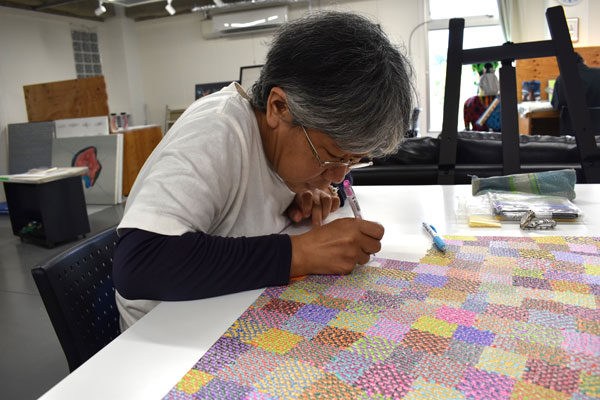
She sometimes draws more than 10,000 people on a piece of paper.
Yamashita: I did not intentionally or strategically make it happen. I just wanted to fulfill their desires rather than conform to societal ideals. When I first met with these people with disabilities, they made a big impression on me. They were enthusiastically constructing their own world.
In the past, I used to worry about what others thought of me. I could not clearly express the fact that I liked something, because I was afraid of being different from others. I used to think I had no choice but to live this way.
That is why I was impressed by people who were able to wholeheartedly focus on their passions, without caring about society's evaluation or whether it was meaningless to others. I found their way of living very admirable. Gradually, I began to think, "I do not want to be disliked by them; I want to be needed by them," which became the starting point for everything.
I do not want to impose my own values and rules on them, saying, "Don't do this. It's meaningless. Do that." I definitely do not want to change them, making them entirely different from their true selves.
Sakakihara: Your belief is admirable. At Atelier Yamanami, there are around 100 members working on various projects. Some have even gained recognition for their artwork to the point where they have staged exhibitions in New York. However, these members do not say, "I want to establish an independent art business"; but instead say, "I want to stay here." They do not care whether their artworks sell or not. For them, it is more important to stay with people who warmly and genuinely accept them in a place they feel comfortable. This is the amazing power of Atelier Yamanami.
Yamashita: The actual reason why they want to stay at Atelier Yamanami is not that they love drawing so much. It is probably because their world feels secure here, or they can stay with people they are fond of.
Most members have experience working at subcontracting jobs, for which they were very good at producing defective goods. They repeatedly failed to produce satisfactory products because they were not good at complying with standards and regulations. In contrast, creative activities like drawing pictures have no concept of failure. Each piece of creative work is considered to be a success. The presence of others with whom they can share a sense of accomplishment and enjoyment is probably the reason they feel comfortable staying at Atelier Yamanami.
Inclusion does not mean we all do the same thing together
Sakakihara: Your facility is located in a sparsely-populated rural area, and members are engaged in artistic activities in a free and relaxed atmosphere. Some may question such a state, asking, "Is it really inclusion?" They believe inclusion involves sharing the same living standards and rules while connecting with a large number of typical people. However, this is a very narrow concept.
If inclusion simply means living and working while being connected with a lot of people, then it means that people living on isolated islands and in marginal villages are not living in an inclusive society. That idea is ridiculous! For instance, if someone sees and becomes interested in the members' artwork created here, that can be a way of inclusion. They are connected through the artwork.
I regularly see children with developmental disorders, and I know that some feel frustrated by constantly having to be with someone. Inclusion should not mean we stay together and do the same thing together. We should reconsider the meaning of "inclusion."
Yamashita: We first care about ensuring that each member can spend each day peacefully. To do so, we need a lot of effort to secure an environment suitable for each member. Some members prefer to spend time alone, while others enjoy group activities. There may be days when a member wishes to be alone. Each member has distinctive characteristics. We should not think of them as a homogeneous group.
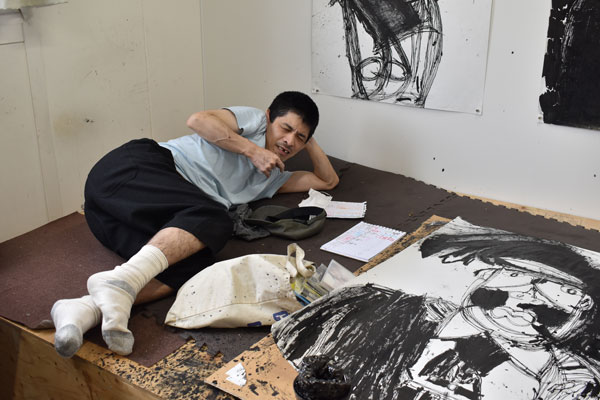
Sakakihara: I think a true inclusive society means a place where individuals can live as they please, without conforming to others' lifestyles.
Yamashita: When I asked some members of Atelier Yamanami, who are referred to as persons with severe disabilities, whether they thought of themselves as disabled, they responded with a resounding "No." Similarly, when I asked them if they were unhappy, they denied it, saying "No, I am indeed happy." And when I asked them if they were pitiful, they denied it, saying "Not at all. I am enjoying myself."
I further asked them, "What is a disability?" They replied, "It means someone says bad things about someone else." I then asked, " What can we do to eliminate disabilities?" Some told me, "We should talk with more and more people and get to know each other better."
They are absolutely right. A difference in values can create a barrier between people and "disable" our relationship. This makes me wonder about how people perceive those with disabilities in this modern world. Perhaps it is more important to promote an accurate understanding of disabilities in those surrounding them to truly support these individuals.
Sakakihara: A lot of people misunderstand what an inclusive society is. They think an inclusive society means everyone lives in a single environment with the same conditions. Those who are outside such an environment are often regarded as disabled, unproductive, or unable to do anything. Artistic activities produce specific artworks, which may be a trigger to draw their attention away from those who misunderstand disabilities. Not everyone will feel something when they see these artworks, but it can have an impact to make a lot of people rethink "So, what was the disability about?".
It is fantastic that these works are not collected from around the country, but that there are so many members engaged in creative activities in Koka City alone, with its small population of about 90,000 people. Just imagine how many people there would be from all over Japan. Considering this, I feel your initiative should be disseminated further.
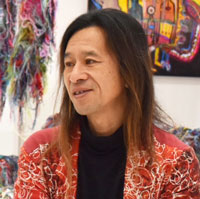 Masato Yamashita
Masato YamashitaDirector of Atelier Yamanami
Mr. Yamashita was born in 1967. After completing high school and trying different jobs, he began working as a member of support staff at the Yamanami Community Workshop in May 1989. This was an unlicensed training center and workshop for individuals with disabilities. In 1990, he established Atelier Korobokkuru as a creative space for individuals with disabilities to engage in diverse activities. Since then, he has been actively involved in various expressive activities aimed at helping people with disabilities to embrace their unique characteristics, thoughts, and pace of life. His goal is to create an inclusive environment where everyone can freely be themselves based on mutual trust relationships. He has been serving as director of Atelier Yamanami since May 2008.
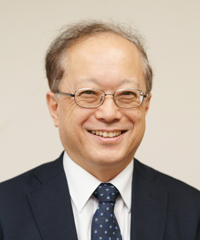 Yoichi Sakakihara
Yoichi SakakiharaM.D., Ph.D., Professor Emeritus, Ochanomizu University; Director of Child Research Net, Executive Advisor of Benesse Educational Research and Development Institute (BERD), President of Japanese Society of Child Science. Specializes in pediatric neurology, developmental neurology, in particular, treatment of Attention Deficit Hyperactivity Disorder (ADHD), Asperger's syndrome and other developmental disorders, and neuroscience. Born in 1951. Graduated from the Faculty of Medicine, the University of Tokyo in 1976 and taught as an instructor in the Department of the Pediatrics before working with Ochanomizu University.
- [Aiming to Realize an Inclusive Society] Providing Inclusive Childcare Means Offering a Wider Variety of Choices for Daily life to All Children
- [Aiming to Realize an Inclusive Society] Shared Practices with Specialists and Parents to Realize Inclusive Childcare
- [Aiming to Realize an Inclusive Society] Creating a Community Where Children and Adults Can Feel WAKUWAKU (Excited) Through Close Collaboration with Educational, Medical and Social Welfare Professionals














